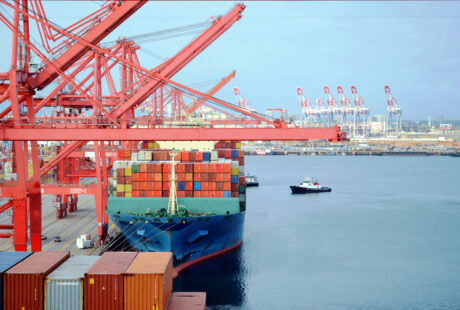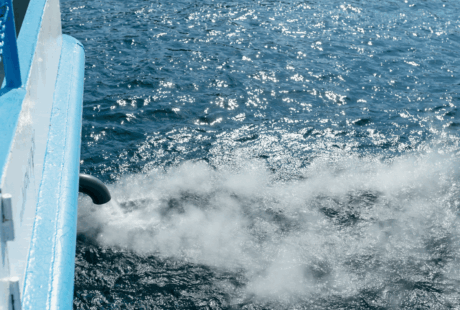Your country could play a decisive role in next year’s UN climate shipping negotiations. Not only could you help determine how quickly global shipping will decarbonise but also ensure that this transition is just and equitable. This funding would be separate and additional to the finance negotiated under the UN Framework Convention on Climate Change (UNFCCC).
Apply for the IMO’s Voluntary Multi-Donor Trust Fund (VMDTF) until 6 December and receive financial assistance to participate in critical discussions in Spring 2025: ISWG-GHG-18 (17-21 February), ISWG-GHG-19 (31 March-1 April), ISWG-APEE-1 (2-4 April), and MEPC 82 (7-11 April).
Learn more about the IMO and the VMDTF fund, as well as the key policy proposals, in our explainer below.
What’s at Stake at the IMO and How to Participate: The United Nations International Maritime Organization (IMO) is a specialised agency that regulates shipping worldwide. In the summer of 2023, the IMO adopted a strategy to equitably clean up and fully decarbonise the shipping industry by 2050, with checkpoints along the way: These points aim for a 30% reduction in greenhouse gas emissions by 2030, and 80% by 2040. In order to fulfil these targets, improved vessel energy efficiency, cleaner fuels and the introduction of a polluters pay levy on heavily polluting vessels must be finalised and adopted in 2025.
These tools currently are being negotiated and designed.
Rice, wheat, fuel and clothes are some of the main imports by sea to Africa. Up to 90% of world trade is carried around the globe by ships, and they are very efficient in supplying the demand for food, fuel, raw materials and goods. If it is in your hand, on your body or in your kitchen, there is a high chance that it travelled to your country by ship.
However, these crucial shipping routes and supply chains face growing threats from climate change. The shipping industry, itself, contributes to 3% of global greenhouse gas emissions, adding to this challenge.
As an IMO Member State, your country can make a difference on the level of ambition in the negotiated policies and how they can benefit your country and communities. It is important that your seat at the table is occupied and that your voice is heard. After all, your country will play a key role in its implementation.
How to apply for this funding and claim your seat? Get your Permanent Mission in London or your Ministry in charge of IMO affairs to send a note verbale to the IMO Secretariate (), accompanied with the completed form that can be found here, by 6th of December 2024. More information about the VMDTF process is also available on the IMO website here (pending an update for the 2025 meetings).
A Hierarchy of Tools for a Smooth Transition
Your presence in 2025 in London at the IMO will help support a successful transition to zero-emission shipping, a goal that all Member States, including your country, committed to last year.
A clear hierarchy of tools, starting with enhancing energy efficiency across the global fleet, followed by adopting advanced propulsion methods – primarily wind technology -is essential to achieve this vision. This is supported by the introduction of a global fuel standard and a strong levy on emissions which are necessary to enhance the transition to zero-emission fuels and generate critical climate funds.
By first focusing on maximising energy efficiency, the industry can significantly reduce its fuel consumption, thereby lowering the overall demand for renewable fuels. Wind propulsion serves as the next step, offering a readily available and scalable solution to further cut emissions. Moreover, wind propulsion can be used by smaller container vessels, which grants them access to smaller, secondary ports that would not necessarily be on the larger more common trade routes. This allows the development of smaller ports and for their communities to access more global goods and foodstuffs.
Finally, the global fuel standard and an ambitious levy of at least $150 per tonne of emissions will drive the transition by setting clear emissions targets and providing the financial incentives needed to support a just and equitable shift away from fossil fuels.
Energy Efficiency – The First Line of Action:
Capitalizing on energy efficiency across the global fleet is one of the largest decarbonisation opportunities. Simple yet effective measures such as regular underwater cleaning with capture can save 6-10% of fuel per voyage, while dry-docking can improve fuel savings by 15-18%. The IMO’s Carbon Intensity Indicator (CII) serves as a crucial tool here, driving the industry to enhance operational efficiency. Strengthening the CII to require an energy efficiency improvement of, for example up to 38% by 2030 compared to 2018 levels, will push the widespread adoption of technologies like wind propulsion and speed reduction.
Propulsion Means – Led by Wind and Supported by the Global Fuel Standard (GFS) and Levy:
Wind technology offers immediate and substantial gains, with retrofitting ships to include wind propulsion potentially saving up to 30% in fuel consumption per voyage. If the global fleet were to adopt wind technology, the demand for renewable fuels could be minimised, allowing more clean energy to decarbonise other sectors. The GFS will further guide this transition by setting limits on the greenhouse gas intensity of fuels. This will incentivise investment in renewable zero-emission fuels, which could potentially be done in your country, and ensure that the switch to cleaner propulsion methods like wind happens in a structured and effective manner.
The Essential Role of an Equitable Levy in a Just Transition
A strong levy, set between $150 and $300 per ton of greenhouse gas emissions as modeled by DNV (MEPC 82/INF.8/Add.1), is crucial for driving environmental impact while ensuring a just and equitable transition. The revenue generated can be redistributed to alleviate the economic shocks that disproportionately affect small island developing states and the least developed countries, who would otherwise bear the brunt of rising freight costs as the industry shifts away from dirty fuels. This financial support is vital to ensure that no country is left behind in the transition to a cleaner shipping industry.
Beyond addressing equity, the levy will also play a pivotal role in preventing costly lock-in to outdated technologies like carbon capture storage. By providing the financial incentives necessary for the adoption of cleaner technologies, a high levy will stimulate investments in energy efficiency and sustainable practices, making the overall transition more affordable and effective. This approach will fund retrofitting ships, building new wind-powered vessels, and bridging the cost gap between fossil fuels and zero-emission alternatives, creating a gradual and lower-cost shift towards a sustainable future for shipping.
The currently most ambitious and equitable proposal at the IMO is for a $150 levy, put forward by the Caribbean and Pacific Island states. If implemented, it could generate up to $60 billion in climate funds a year for a just and equitable transition.
The IMO is at a historic crossroads where an integrated approach can lead to a win-win scenario for both the shipping industry and the global community. By ensuring that energy efficiency, global fuel standards, and an ambitious, equitable levy work hand in hand, governments would steer the industry toward a sustainable future. This strategy will not only make the transition smoother and more cost-effective but will also unlock new economic opportunities and protect those most vulnerable to the changing dynamics of global trade. By embracing this three-pronged approach, the IMO can lead the world in climate action, showcasing how collective effort can drive both environmental and economic progress.
Take part in this unique opportunity and help chart a course towards a cleaner, fairer, and more resilient shipping industry, by claiming your seat at the IMO next year with the help of the VMDTF!
Posted on: 14 November 2024



